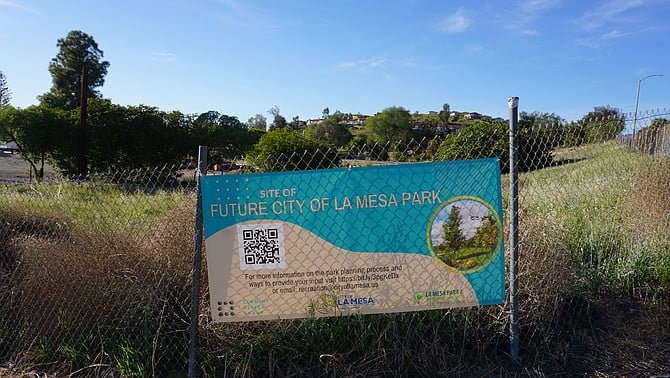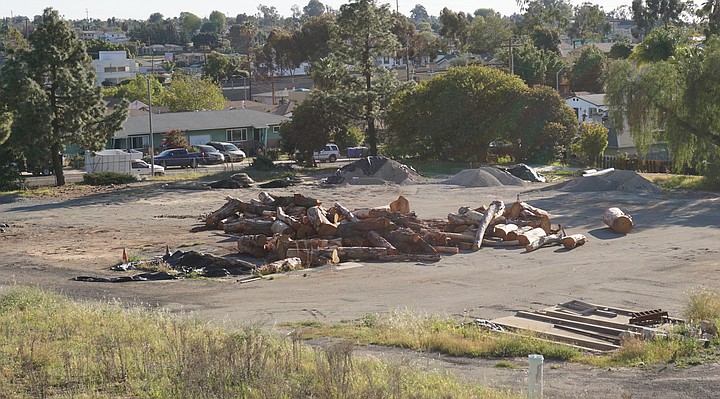 Facebook
Facebook
 X
X
 Instagram
Instagram
 TikTok
TikTok
 Youtube
Youtube

The city of La Mesa is planning to turn a 2.84-acre lot on the northwest corner of Waite Drive and Murray Hill Road (just north of Highway 94 near Massachusetts Avenue) into a new community park. The property was purchased by the city from the county in July 2012. It was the former location of the Lemon Grove Road Station — a County of San Diego public works yard.
“When public land goes up like that and they are going to sell the property, they will do a first right of refusal to local agencies,” Susan Richardson, the director of community services for the city of La Mesa explains. “So, the city of La Mesa basically had a first right to purchase the property before it went out for sale. The City negotiated with the county to purchase the land with the intention to make it into a park.”
She continues, “We purchased the property using park development fee money. Those are fees that developers pay into the city to mitigate new development for new residential development. We purchased it over about a four-year period. We made payments on it to the county before we owned it outright.”
Due to the former use of the property, a large environmental clean-up was required before the land could be sold.

“They did what is called ‘brownfield’ [a tract of land that has been developed for industrial purposes, polluted, and then abandoned] clean up,” Richardson says. “Basically, they got some EPA funding to clean the site of any environmental hazards. They did maintenance of their vehicles there. They decontaminated or cleaned up the site. Then the city was given the option to purchase it and we also did other testing to make sure the site was clean before we bought it.”
The city received funding through the California Department of Recreation program last December to create a master plan for the proposed park. This was secured with the help of state assemblymember Akilah Weber, who formerly served on La Mesa’s city council. The next step is to gauge public opinion to determine what the members of the community actually want in the new park. This process began with a recent, public Zoom meeting which was setup by the city to, “gather input, feedback and priorities on desired amenities and character of the park.”
“It’s a clean slate. It’s 2.8 acres,” Richardson explains. “You can’t put a lot of stuff in that amount of space. So, the public will probably come up with this really long list of desired amenities, but they won’t fit. They will have soccer fields, pickle ball, a playground…we’ll have a list way longer than what we can physically fit into the space. Then we will have to narrow it down and say, ‘Well, it’s a neighborhood park, what are the priorities?’ A playground might be the priority or a picnic area. We can only fit so many things into the space because it’s a small park.”
Richardson expects the master plan process to continue through most of this year. After designs and costs are finalized, the real fun begins — finding the money to build.

“A master plan is a dream,” Richardson says. “What are your needs and what would you like? And then we search like crazy looking under rocks and applying for every grant that we can to try to fund those desires. A perfect example is the Collier Park [on Palm Avenue in La Mesa] master plan that we are finally getting to the next stage of renovation. It’s the city’s oldest park. That’s also a ten-year plan. The park master plan was finished ten years ago, and it has taken that long to raise the money to be able to make improvements.”
The new park property is fenced off and is being used for staging and laydown by partner agencies to the city. If you peek through the fence, you may notice a large amount of cut wood on the site. These are the remains of huge eucalyptus trees that were recently removed from Collier Park. Richardson is hoping that this wood can be repurposed for nature playgrounds at both the future park on Waite Drive and at Collier Park. There is a nature playground like this near the Balboa Tennis Club in Balboa Park.
“They were the first ones in the city of San Diego,” Richardson says. “Eucalyptus trees are kind of hazardous in parks, so they had to remove a bunch there and they did the very first kind of nature playground in our region, and I think they have done a couple of others since then in other San Diego parks.”
As for the name of the new park, Richardson says they have been referring to it as Waite Drive Park in reference to the street that you access it from. She adds that the street is named after a real-estate developer, J.W. Waite, who owned the land and developed the Vista La Mesa area. They don’t seem to know much else about him.
“We kind of refer to it as Waite Drive Park, but we’re like, ‘Do we want to name it after this guy? We better do some background checks on him to make sure he was a good guy.’”


The city of La Mesa is planning to turn a 2.84-acre lot on the northwest corner of Waite Drive and Murray Hill Road (just north of Highway 94 near Massachusetts Avenue) into a new community park. The property was purchased by the city from the county in July 2012. It was the former location of the Lemon Grove Road Station — a County of San Diego public works yard.
“When public land goes up like that and they are going to sell the property, they will do a first right of refusal to local agencies,” Susan Richardson, the director of community services for the city of La Mesa explains. “So, the city of La Mesa basically had a first right to purchase the property before it went out for sale. The City negotiated with the county to purchase the land with the intention to make it into a park.”
She continues, “We purchased the property using park development fee money. Those are fees that developers pay into the city to mitigate new development for new residential development. We purchased it over about a four-year period. We made payments on it to the county before we owned it outright.”
Due to the former use of the property, a large environmental clean-up was required before the land could be sold.

“They did what is called ‘brownfield’ [a tract of land that has been developed for industrial purposes, polluted, and then abandoned] clean up,” Richardson says. “Basically, they got some EPA funding to clean the site of any environmental hazards. They did maintenance of their vehicles there. They decontaminated or cleaned up the site. Then the city was given the option to purchase it and we also did other testing to make sure the site was clean before we bought it.”
The city received funding through the California Department of Recreation program last December to create a master plan for the proposed park. This was secured with the help of state assemblymember Akilah Weber, who formerly served on La Mesa’s city council. The next step is to gauge public opinion to determine what the members of the community actually want in the new park. This process began with a recent, public Zoom meeting which was setup by the city to, “gather input, feedback and priorities on desired amenities and character of the park.”
“It’s a clean slate. It’s 2.8 acres,” Richardson explains. “You can’t put a lot of stuff in that amount of space. So, the public will probably come up with this really long list of desired amenities, but they won’t fit. They will have soccer fields, pickle ball, a playground…we’ll have a list way longer than what we can physically fit into the space. Then we will have to narrow it down and say, ‘Well, it’s a neighborhood park, what are the priorities?’ A playground might be the priority or a picnic area. We can only fit so many things into the space because it’s a small park.”
Richardson expects the master plan process to continue through most of this year. After designs and costs are finalized, the real fun begins — finding the money to build.

“A master plan is a dream,” Richardson says. “What are your needs and what would you like? And then we search like crazy looking under rocks and applying for every grant that we can to try to fund those desires. A perfect example is the Collier Park [on Palm Avenue in La Mesa] master plan that we are finally getting to the next stage of renovation. It’s the city’s oldest park. That’s also a ten-year plan. The park master plan was finished ten years ago, and it has taken that long to raise the money to be able to make improvements.”
The new park property is fenced off and is being used for staging and laydown by partner agencies to the city. If you peek through the fence, you may notice a large amount of cut wood on the site. These are the remains of huge eucalyptus trees that were recently removed from Collier Park. Richardson is hoping that this wood can be repurposed for nature playgrounds at both the future park on Waite Drive and at Collier Park. There is a nature playground like this near the Balboa Tennis Club in Balboa Park.
“They were the first ones in the city of San Diego,” Richardson says. “Eucalyptus trees are kind of hazardous in parks, so they had to remove a bunch there and they did the very first kind of nature playground in our region, and I think they have done a couple of others since then in other San Diego parks.”
As for the name of the new park, Richardson says they have been referring to it as Waite Drive Park in reference to the street that you access it from. She adds that the street is named after a real-estate developer, J.W. Waite, who owned the land and developed the Vista La Mesa area. They don’t seem to know much else about him.
“We kind of refer to it as Waite Drive Park, but we’re like, ‘Do we want to name it after this guy? We better do some background checks on him to make sure he was a good guy.’”
Comments